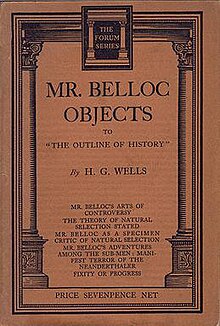Мистер Беллок возражает против «схемы истории»
 Первое издание обложки | |
| Автор | HG Wells |
|---|---|
| Language | English |
| Genre | Fiction |
| Publisher | Methuen & Co. Ltd. |
Publication date | 1926 |
| Publication place | United Kingdom |
| Media type | Print (Paperback) |
| Pages | 55 |
Мистер Беллок возражает против «Схема истории» - это короткая книга 1926 года, написанная британским писателем Х.Г. Уэллсом как опровержение критики историка Илаэр Беллока . В 1926 году Беллок опубликовал свой компаньон в «Схема истории» мистера Уэллса как критику более раннего исторического учебника Уэллса « Схема истории» . Благодарный римско -католик, Беллок был глубоко обижен из -за обращения Уэллса к христианству в контуре .
Конфликт
[ редактировать ]Уэллс опубликовал свой план в 1920 году как универсальную историю - та, которая занимается большим, чем «царствование, родословные и кампании». [ 1 ] Уэллс приступил к своему схемам в результате своей работы с Лигой Наций [ 2 ] и желание помочь миру во всем мире, предоставив миру «общие исторические идеи». [ 3 ] Схема оказалась обширной, всеобъемлющей работой. У Уэллса была группа специалистов, чтобы рассмотреть и проверить его работу. Хотя группа раскрыла много неизбежных «пробелов, ошибок и неправильных процессов», [ 4 ] Wells reserved the right to "maintain his own judgments".[5] В результате в контур содержалась то, что было утверждено Belloc, как ряд предвзятых утверждений, нетерпимых утверждений и ложных предположений. Материалистический детерминизм рассматривался как центральная философия, лежащая в основе контура, когда Уэллс изображает человеческий прогресс как слепой и неизбежный подъем от тьмы религиозного суеверия до света научной утопии.
Hilaire Belloc was the most lively and argumentative of Wells' critics to take aim at The Outline. A devout Roman Catholic and staunch defender of the faith, Belloc attacked Wells' portrayal of religion in general and the Catholic Church in particular. He accused Wells of prejudiced provincialism and attacked his tacitly anti-Christian stance, stating that he had devoted more space in his "history" to the Persian campaign against the Greeks than he had to the figure of Christ. Belloc's anger led him to take personal shots at Wells, accusing the writer of having "the very grievous fault of being ignorant that he is ignorant". He accused Wells of having the "strange cocksuredness of the man who knows only the old conventional textbook of his schooldays and mistakes it for universal knowledge."[6]
Belloc wrote a series of twenty-four articles attacking The Outline, publishing them in Catholic magazines such as Universe, Southern Cross and Catholic Bulletin. In 1926, Belloc assembled the voluminous articles into a single volume entitled A Companion to Mr. Wells’s "Outline of History".
Wells responded to Belloc's articles with a series of six of his own, and found little interest in the academic dispute outside the Catholic publications. As an incentive, he offered the Catholic magazines the use of the articles for no payment; they declined. Wells responded to the refusal in a letter to the Universe:
I am sorry to receive your letter of 19 May. May I point out to you that Mr. Belloc has been attacking my reputation as a thinker, writer, an impartial historian and an educated person for four and twenty fortnights in the Universe? He has misquoted; he has misstated. Will your Catholic public tolerate no reply?[7]
A month later, the editor of the Universe offered Wells the opportunity of correcting definite points of fact upon which he might have been misrepresented.[8] The editor added the stipulation that Wells would not be allowed to defend his views or examine Belloc's logic. Wells then turned to secular publications, and found no interest. He then edited his articles and assembled them into a single volume, his Mr. Belloc Objects to “The Outline of History”.
Like Belloc, Wells resorted to personal attacks, accusing Belloc of being "the sort of man who talks loud and fast for fear of hearing the other side", and declaring that "his apparent arrogance is largely the protection of a fundamentally fearful man."[9]
Belloc retaliated with Mr. Belloc Still Objects.
References
[edit]- ^ Wells, H. G., The Outline of History, Garden City Publishing Company, Inc.; New York, 1930, page vi.
- ^ Dickson, Lovat, H.G. Wells: His Turbulent Life and Times. Penguin Books, 1972, page 318.
- ^ Wells, H. G., Outline, page vi.
- ^ Dickson, H. G. Wells, page 326.
- ^ Dickson, H. G. Wells, page 327.
- ^ Coren, Michael, The Invisible Man: The Life and Liberties of H. G. Wells, Jonathan Cape, page 32
- ^ Wells, H. G., Mr. Belloc Objects to "The Outline of History", Watts and Company, 1926, page v.
- ^ Wells, H. G., Mr. Belloc Objects, page vi.
- ^ Wells, H. G., Mr. Belloc Objects, page 7.
External links
[edit]- Full text of Mr. Belloc Objects to "The Outline of History" at the Internet Archive